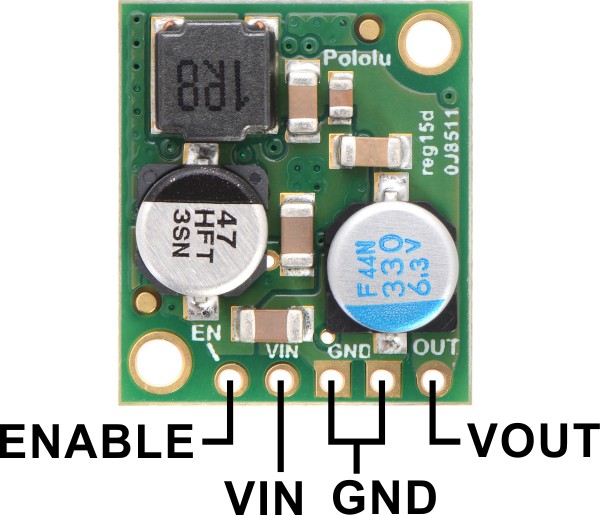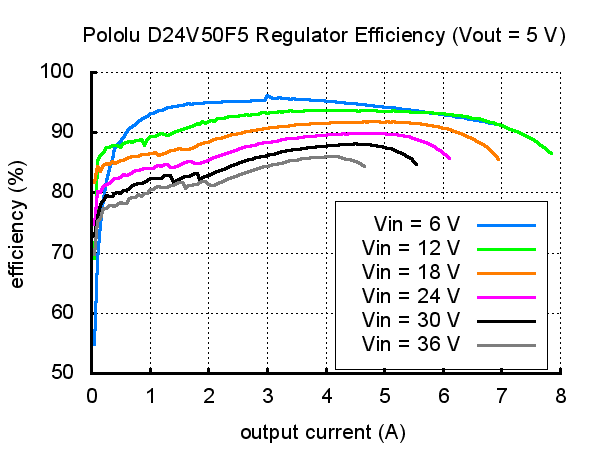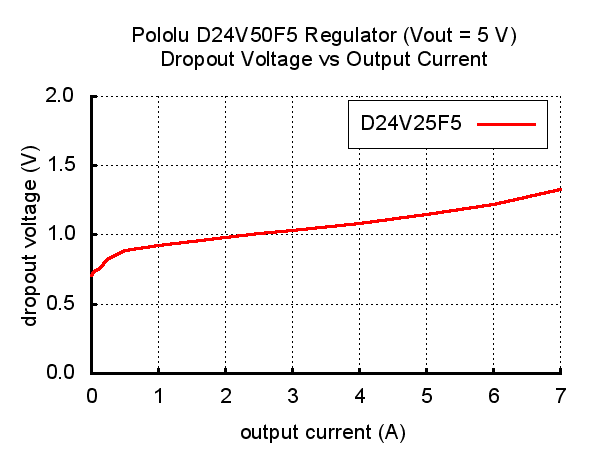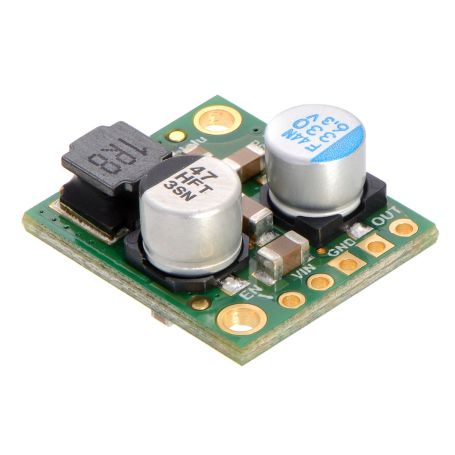5V 5A regulator, step down, D24V50F5
D27V50F5 Switching DC-DC regulator, 5V 5A, Step-Down
- Output voltage: 5V (and possibility to configure lower)
- Input voltage: 38V max
- Output current: ~5 A max
Payments are secured by LyraCollect, a French payment collection company.
It is possible to delivered to your home, to a pick-up point or picked up by appointment at MCHobby
We prepare, pack and ship your orders with great respect and care.
A DC-DC 5V regulator for high-power applications
This is a high-current step-down regulators (also named "buck") that generates 5 V output from input voltages up to 38 V. It use a switching regulators (also called DC-to-DC converters) and offers a typical efficiency of 85% to 95%.
The max output current depend on the input voltage and efficiency (see the Typical Efficiency and Output Current section below). The output current can be as high as 5 A.
The ENABLE pin can be used to put the board in a low-power state that reduces the quiescent current to approximately 10 µA to 20 µA per volt on VIN.
This regulator has built-in reverse-voltage protection, thermal shutdown (activated at 160°C), short-circuit protection, and under-voltage lockout (the regulator to turn off when input voltage < 4.2 V).
The extra feature "soft-start" reduces inrush current at startup.
Features
- Input voltage: 4.5 to 38 V
- Fixed 5 V output (4% accuracy).
- Typical maximum continuous output current between 4 A to 5 A
- Integrated protection: reverse-voltage, over-current, over-temperature, under-voltage lockout
- soft-start
- Typical efficiency of 85% to 95% (depends on input voltage and load).
- Quiescent current: 800 μA typical no-load.
Can be reduced to 10 µA to 20 µA per volt on VIN by disabling the board - size: 17.8 × 20.3 × 8 mm
- 2x M2 screws
- Small holes for 2.54 header pins
Wiring
This buck regulator has 5 connections: VIN, 2xGND (ground), VOUT (output voltage) and ENABLE.

- VIN : input voltage. Powers the regulator and can be supplied with voltages from 4.5V up to 38V.
The effective lower limit of VIN is VOUT plus the regulator’s dropout voltage, which varies approximately linearly with the load from around 500 mV to 1.5 V (see below for a graph of the dropout voltage as a function of the load). - VOUT : output voltage. Is set to 5V by default.
- ENABLE pin : The regulator is enabled by default with a 100 kΩ pull-up resistor on the board connects the to reverse-protected VIN.
The ENABLE pin can be driven low (under 0.6 V) to put the board into a low-power state. The quiescent current draw in this sleep mode is dominated by the current in the pull-up resistor from ENABLE to VIN and by the reverse-voltage protection circuit, which will draw between 10 µA and 20 µA per volt on VIN when ENABLE is held low. If you do not need this feature, you should leave the ENABLE pin disconnected.
Efficiency and output current
The voltage regulator efficiency is defined as (Power out)/(Power in). It is an important measure of the performance, especially when battery life or heat are concerns.
The graph below whos the switching regulators efficiency. The efficiency of 85% to 95% for most combinations of input voltage, and load. A lower efficiency imply a high power dissipation (then dissipate more heat).

The maximum output current of the board depends of several factors:
- the ambient temperature,
- air flow,
- heat sinking
- input and output voltage.
Efficiency, temperature and max current
During normal operation, this product can get hot enough to burn you. Take care when handling this product or other components connected to it.
The over-current limit of the regulator operates on a combination of current and temperature: the current threshold decreases as the regulator temperature goes up. However, there might be some operating points at low input voltages and high output currents (well over 5 A) where the current is just under the limit and the regulator might not shut off before damage occurs. If you are using this regulator in an application where the input voltage is near the lower limit and the load could exceed 5 A for sustained periods (more than five seconds), consider using additional protective components such as fuses or circuit breakers.
Typical dropoup voltage
The dropout voltage of a step-down regulator is the minimum amount by which the input voltage must exceed the regulator’s target output voltage in order to ensure the target output can be achieved.
Ex: if a 5 V regulator has a 1 V dropout voltage, the input must be at least 6 V to ensure the output is the full 5 V.
The following graph shows the dropout voltage for the regulator as a function of the output current:














